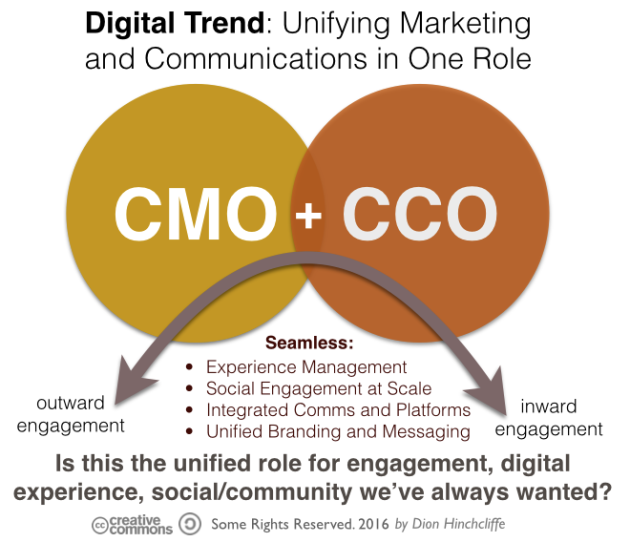Restructuring the C-Suite for Digital Business: The Future of the CMO, CCO, CIO, and CDO
April 24, 2016 2 Comments
I’ve noticed lately what appears to be an emerging trend in marketing and communications leadership in some large companies. Specifically, the positions of chief marketing officer (CMO) and chief communications officer (CCO) are sometimes being consolidated into a single role, even in very large enterprises. Such consolidation has already happened at PG&E, Walgreens, and Citi, and I’ve recently encountered other notable instances as well. This might seem odd at first glance, as specialization of roles is usually emphasized in large entities as expansive purviews tend to be harder to manage.
It actually turns out, for several key reasons, that examining this closer is an interesting — and both useful and practical — thought exercise in how the single vast continuum of digital is putting growing pressure on the traditionally separated functional silos that have comprised most of our organizations for over a century.
This trend, and another like it I’ll propose we’ll see soon, is actually an apparent reversal of what organizations have been doing lately to better organize for technology, which is moving to the very center of how our organization operate and create value. In fact, the proliferation of C-level stakeholders for the rapidly expanding world of digital business has continued unabated in recent years, as chief data officers, digital officers, community officers, experience officers, analytics officers, and other similar C-level tech roles emerge and grow rapidly.
Too many cooks in the kitchen, some might say, but I pointed out last week on ZDNet that digital disruption — a wildly overused yet still quite apt phrase of our times — is now anticipated by most executives within the current planning cycle. The counter argument that is made for proliferation is that we need a lot more leadership on deck to more rapidly adapt our organizations to digital and head off disruption. The imperative is that we now have to a) think more like venture firms and startups, in other words our digital efforts have to move out of the quarter earnings cycle and become long term, while shifting to experimenting and failing fast until finding what works and b) our organizations require digital change capacity that is matched to today’s exponential cycle of technology evolution. Without both, we can’t maintain a sustainable pace matched to the market or reach a successful future state quickly enough.
In fact, what’s often hampering us in fact functional silos, both in our org structures and in our technology. We saw this very painfully with social media and social business a few years ago, and now we are witnessing it writ large as our customer experiences, the vital journey of which is the very lifeblood of our organizations, becomes ever more fragmented and divided across digital channels and our organizations’ operational silos. Customers get thrown over the wall to disorganized and inconsistent experiences as their journey takes them through our marketing departments, sales teams, customer service staff, and product development groups. Increasingly, our attempts to engage with companies as a customer is just ignored as we use new digital touchpoints that is obviously so much better — to us, but still unfamiliar to companies. In short, as organizations, we don’t have the capacity to be everywhere we are expected to be in the customer journey, and as organized today, don’t have a way to get there.
So how does the convergence of top-level roles in communications and engagement solve this problem? By removing a key silo while also adding the responsibility for both internal and external comms. Internal comms in particular is a critical addition, and is a key part of what a corporate communication officers oversee, as they are often the sponsor for the corporate ESN and intranet, essential platforms for organizing change at scale. As gaining holistic and integrated oversight and control of experience management — across customers, business partners, and employees — has become paramount, this merging of roles gives us a way to prevent it from fragmenting across projects, initiatives, technologies, tools, and digital channels. No more dividing internal and external engagement, giving us less inconsistent messaging and responses. In return, we can achieve better internal scale, more unified platforms, policies, and governance. We have one role for primary engagement.
In other words, with CMO and CCO consolidation, we will have a single top-level org structure that is substantially better suited to oversee engagement across the single continuum of digital. We used to think that digital/social centers of excellence were required to bring together a consistent response to technology. This may be a better answer.
We will see how this trend plays out — and there are still open questions about where secondary engagement such as customer care and product development fit in — so I have begun tracking the industry data in LinkedIn to see if we can confirm a real trend based on my and others anecdotal experience. But from an critical thinking standpoint it makes sense why organizations are doing this.
The Fall of the Chief Digital Officer Too?
Which brings to my second trend, which is that we’ll likely see the same consolidation of function happen with the chief information officer (CIO) and the chief digital officer (CDO). I was initially bullish on the CDO a few years back — and still think they have an important combined innovation and P&L role to play, but as some like Theo Priestley have observed, the role is already under pressure and it’s time is likely to come to an end, at least as a top-level role. It will still exist of course but in this consolidation, would appear under the CIO purview. It now seems likely that many CIOs will merge CDO functions back in for all the same arguments that the CMO and CCO purviews should be combined.
Following this argument, removing silos in our organizations so that we can remove them from our digital products and experiences makes sense on its face. It can eliminate friction, make it possible to scale better, reduce poor execution, and create more shared value. I should point out however, it’s only part of the story for organizing better for digital. While other related topics like the bi-modal/multi-modal conversation seems to have hit a fever pitch, with McKinsey even joining the bandwagon, I think it’s vital that we also carefully consider simpler “digital hacks” to our organization that should be far easy to implement, but would in practice have significant impact.
Consequently, the consolidation of top digital roles into a chief marketing and communications officer (CMCO) and chief information and digital officer is — I now believe — a practical response to the proliferation of C-level digital roles to create the consistency, coherency, and effectiveness we need to change. However, this centralization will be an improvement as long as — and only as — such consolidation is properly balanced by bottom up and grassroots digital change programs, like a network of excellence powered by decentralized change agents, or a formally supported Shadow IT and marketing technology program. Without realizing both C-level role consolidation and networks of change together, sufficient digital scale and capacity will simply not exist for converged leadership to cultivate and guide.
Additional Reading
How Should Organizations Actually Go About Digital Transformation?
The digital transformation conversation shifts to how | ZDNet





























































Pingback: Petervan’s Delicacies – Week 25 Apr 2016 | Petervan
Pingback: The Full Monty — April 25, 2016 | experts' corner